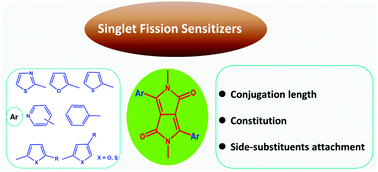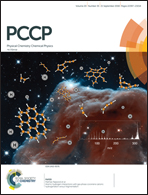Effects of aromatic substituents on the electronic structure and excited state energy levels of diketopyrrolopyrrole derivatives for singlet fission†
Abstract
Singlet fission (SF) is a spin-allowed process, which is expected to be a feasible strategy to realize photon downward conversion. To achieve a significant increase in the photoelectric conversion efficiency of solar cells, SF molecules should have not only a high SF efficiency, but also suitable energies of the first singlet excited state [E(S1)] and the first triplet excited state [E(T1)] to act as SF sensitizers in solar cells. Aryl-substituted diketopyrrolopyrrole (DPP) is one of the few organic molecules, which can undergo SF efficiently after photoexcitation. In order to find suitable DPP-based SF sensitizers for solar cells, we designed a series of DPP derivatives by varying aromatic substituents, including changing the conjugation and constitution of aromatic substituents, as well as introducing side-substituents on the aromatic substituents. Detailed analysis focused on the molecular structures, the frontier molecular orbitals, multiple diradical characters, and SF relevant excited-state energy levels. The results indicate that introduction of no more than two aromatic rings and modification of the aromatic rings with side-substituents are both practical ways to get suitable SF sensitizers for solar cells. This work would give a deep understanding of DPP-based SF molecules, and pave the way towards the development of new DPP-based SF sensitizers for solar cells.



 Please wait while we load your content...
Please wait while we load your content...